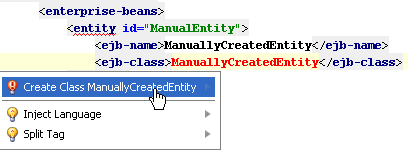Creating EJB
This feature is supported in the Ultimate edition only.
IntelliJ IDEA provides the following ways to create beans:
- Manually, by means of direct editing the
ejb-jar.xmlfile, using the extensive coding assistance provided by IntelliJ IDEA. - Using the context menu commands.
To create an Enterprise Java bean using the editor
- Open the deployment descriptor file
ejb-jar.xmlfor editing. - Create the
<enterprise-beans>section. - In this section, create tags for the desired bean types:
<session>,<entity>, or<message-driven > - Specify the bean name and class by adding tags
<ejb-name>. and<ejb-class>. Note that you can specify the target package in this tag, for example,samples.ejb.ManuallyCreatedEntity, using code completion after each dot. - If the declared class does not yet exist, IntelliJ IDEA suggests a quick fix:

Choose from the suggestion list. If the target package was not defined in the
<ejb-class>tag, select the desired package in the Choose Destination Directory dialog box. The stub class is created in the specified location. - Proceed with defining the other bean components.
To create an Enterprise Java bean, follow these general steps
- Open the EJB tool window.
- Right-click the desired module, choose on the context menu, and then select the bean type on the submenu.
The New <bean type> Bean dialog box opens.
- Specify the bean name, class and package.
- Define the bean-specific settings:
- For Entity beans (1.x and 2.x) and Session beans (1.x and 2.x), configure local and remote interfaces.
- For Entity beans (1.x and 2.x), configure primary keys and CMP bean fields.
- For Message beans, configure message listener.
- For Session beans, configure service endpoint.
Last modified: 29 November 2017